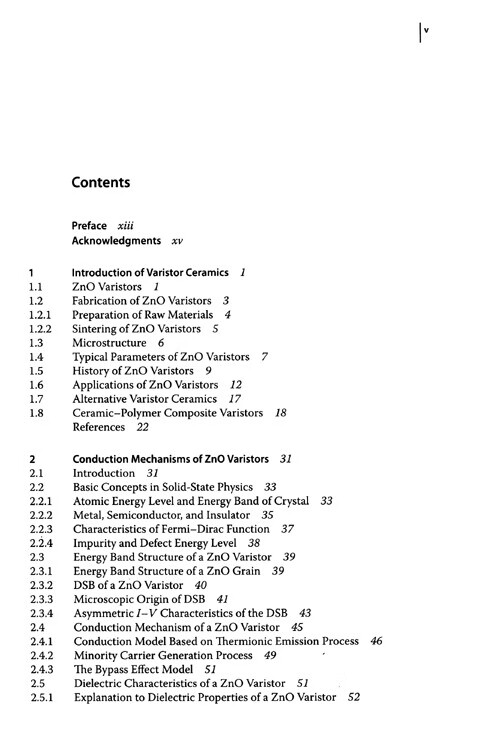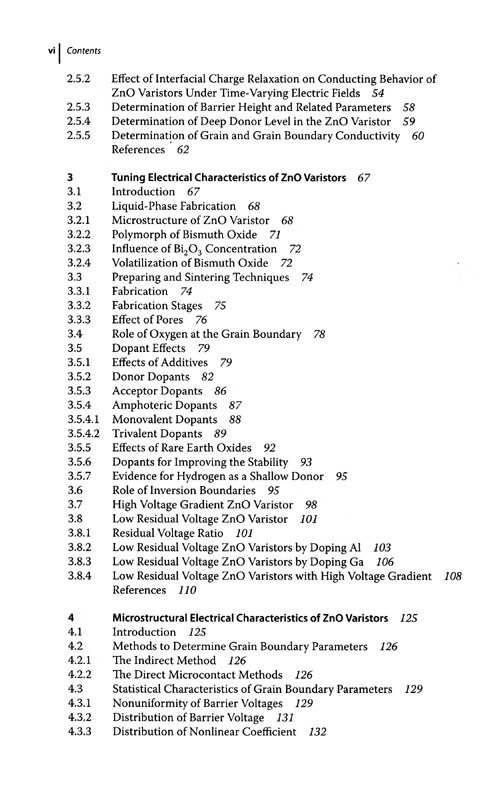Introduction of Varistor Ceramics
Zinc oxide (ZnO) varistor, which is a kind of polycrystalline semiconductorceramic composed of multiple metal oxides and sintered using conventionalceramic technology, is a voltage-dependent switching device, which exhibitshighly nonohmic current–voltage characteristics above the breakdown voltage.Basic information on ZnO varistors, including the fabrication, microstructure,and typical electrical parameters, is introduced. The history and applications ofZnOvaristorsarealsopresented.Thepanoramaofalternativevaristorceramicsfor Bi2O3-based ZnO varistors is mapped out. Especially, the ceramic–polymercomposite varistors with lower breakdown voltage, incorporating varistorparticlessuchassemiconductingparticles,acombinationofmetalandsemiconducting particles, and ZnO microvaristors, in a polymeric matrix are reported.Now, varistors are available that can protect circuits over a very wide range ofvoltages, from a few volts for low voltage varistors in semiconductor circuits to1000kVACand ±1100kVDCinelectricalpowertransmissionanddistribution networks. Correspondingly,theyalsocanhandleanenormousrangeofenergiesfromafewjoulestomanymegajoules.
1.1 ZnO Varistors
A varistor is an electronic component with a “diode-like” nonlinear current– voltage characteristic, which is a portmanteau of variable resistor [1]. Function-ally,varistorsareequivalenttoaback-to-backZenerdiodeandaretypicallyusedin parallel with circuits to protect them against excessive transient voltages insuch a way that, when triggered, they will shunt the current created by the highvoltageawayfromsensitivecomponents.
The most common type of varistor is the metal oxide varistor (MOV), whichcontains a ceramic mass of ZnO grains, in a matrix of other metal oxides, suchas small amounts of bismuth, cobalt, and manganese, sandwiched between twometal electrodes. The boundary between each grain and its neighbor controlsthe current according to the applied voltage, and allows current to ?ow in twodirections. The mass of randomly oriented grains is electrically equivalent to anetworkofback-to-backdiodepairs,eachpairinparallelwithmanyotherpairs.Avaristor’sfunctionistoconductsigni?cantlyincreasedcurrentwhenvoltageisexcessive.Onlynonohmicvariableresistorsareusuallycalledvaristors[1].
In normal use, a varistor is subject to a voltage below its characteristic breakdown voltage and passes only a tiny leakage current. When the voltage exceedsthe breakdown voltage, the varistor becomes highly conducting and draws alargecurrentthroughit,usuallytoground.Whenthevoltagereturnstonormal,the varistor returns to its high-resistance state [2]. The result of this behavior isa highly nonlinear current–voltage characteristic [3–5], in which the MOV hasa high resistance at low voltages and a low resistance at high voltages; usually,the resistivity of a ZnO varistor is more than 1010 Ω cm below the breakdown voltage, whereas it is less than several ohm-centimeters above the breakdownvoltage [6]. The switch is reversible with little or no hysteresis although it candegrade under electrical loading [2]. A varistor remains nonconductive as ashunt-mode device duringnormaloperation when thevoltageacrossit remains wellbelowits“clampingvoltage”;thusvaristorsaretypicallyusedforsuppressingline voltage surges. However, a varistor may not be able to successfully limita very large surge from an event such as a lightning strike where the energyinvolvedismanyordersofmagnitudegreaterthanitcanhandle.Follow-throughcurrent resulting from a strike may generate excessive current that completelydestroysthevaristor[1].
ZnO varistors are voltage-dependent switching devices, which exhibit highlynonohmic current–voltage (I–V) characteristics above the breakdown voltage. The nonohmic I–V characteristics are usually expressed logarithmically, asshown in Figure 1.1 [6]. The degree of nonohmic property is usually expressedbyanonlinearcoe?cient ?? de?nedbythefollowingequation:
?? = V dV (1.1)
I dI
Empirically,thefollowingsimpleequationisused:
( V )?? I = (1.2)
C
Current density (A cm–2)
Figure 1.1 I–V characteristicsofatypicalZnOvaristor.Source:AdaptedfromEda[6].
1.2 Fabrication of ZnO Varistors
Figure 1.2 ThewurtzitestructureofZnO. Source:AdaptedfromAddison[7].
whereC isaconstant.Typical?? valuesofZnOvaristorsarefrom30to100;therefore,thecurrentvariesbyordersofmagnitudewithonlysmallchangesinvoltage.A more accurate measure of the nonlinearity is the dynamic conductance, thedi?erentialofthe characteristic,ateach voltage[2]. Onthecontrary, ?? values of conventionalvaristorssuchasSiCvaristorsdonotexceed10.
The I–V characteristics of ZnO varistors are classi?ed into three regions, asshowninFigure1.2[6].InregionI(lowelectrical?eldregion,orpre-breakdownregion), below the breakdown voltage (typically a voltage at 1 μAcm?2), thenonohmic property is not so prominent and can be regarded as ohmic, andthe leakage current is highly temperature dependent. In region II (mediumelectrical ?eld region, nonlinear region, or breakdown region), between thebreakdownvoltageandavoltageatacurrentofabout100Acm?2,thenonohmic propertyisveryprominentandalmostindependentoftemperature.InregionIII (high electrical ?eld region or upturn region), above 100Acm?2, the nonohmic property gradually decays, and the varistor is again ohmic. These three regionsin engineering applications are also called as the low current region, mediumcurrentregion,andhighcurrentregion,respectively.
展开

